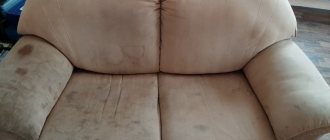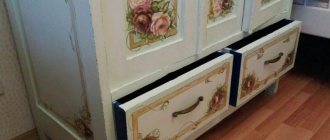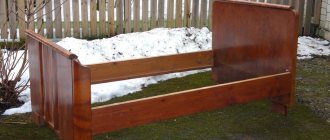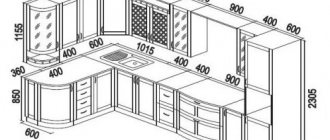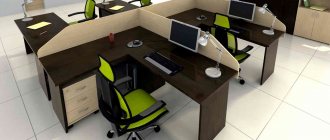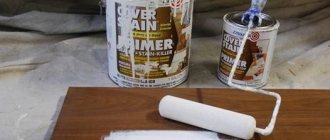Unfortunately, nothing lasts forever. The same problem also affected the color of the furniture.
But there’s nothing wrong with that, the solution to this problem is quite simple - after all, you can repaint it yourself and restore its former attractiveness using such an inexpensive and very effective method.
By refreshing the appearance of your favorite furniture with paint, you can give it even more originality and originality.
If you are the owner of antique furniture and do not want to throw it in the trash, we recommend that you familiarize yourself with the technology of painting it.
Believe me, this way you will significantly save your budget.
What are the reasons for updating the color of furniture
You can see the external problem areas of outdated polished furniture products with the naked eye.
Let's say that seeing that the top polishing layer begins to gradually peel off, and the surface has noticeably darkened, is already the “first bell” that painting is already urgently necessary.
Restoration of polished furniture is also necessary if mesh, cracks, chips, scratches, abrasions and other defects are found on its base.
If the furniture is antique, then the presence of distortions on it will not “steal” its value, which cannot be said about ordinary furniture.
“Deterioration in appearance already indicates immediate repair of the furniture structure. If it was varnished, then you can do the painting yourself, since the help of a specialist can “cost you a pretty penny.”
Even painting it yourself can preserve its wood structure. At the same time, you can change the texture of the product if you wish, and make it in a dark, white or even bright tone.”
Is it possible not to remove the old varnish?
If you start reading recommendations from professional builders, they all agree: old varnish must be removed before new painting. This is what building canons recommend. But in real life, you can try to move away from them - and get excellent results. Thousands of examples prove this! So the answer to the question: is it possible not to remove the old varnish? Yes, you can.
Often a chance to repaint is given to furniture that has only two options: to the landfill or to a new life, if the experiment is successful. If what you have in front of you is not the most valuable piece of furniture, then you can take a risk. Because no one can give a 100% guarantee of a successful result. If it is almost an antique, then you can work on restoration only after removing the layer of old varnish.
Choosing paint and other accessories
To restore the former attractiveness and paint your favorite polished furniture, you need to acquire only high-quality paint products.
First of all, they must be “friendly” with the wood surface, since its further “life” depends on this.
It is also worth paying attention to the effectiveness of the paint (and it can vary). For metal elements (for example, handles) you will need a paint for metal, otherwise their coating will simply peel off.
In turn, paint for wood products must have:
- moisture resistance;
- resistance to abrasions, rapid deterioration, dirt, mechanical stress and chemicals;
- withstand low temperatures (when polished furniture is outdoors);
- long-term operation and preservation of efficiency.
After removing the initial coating, you can paint it to suit any taste and color.
Depending on your preferences and the color compatibility of the design with the interior, you can create the effect of matte, semi-matte, smooth or transparent surface.
If you decide to transform polished furniture into white by painting, then a translucent paint coating will help you (matte will age the appearance a little).
The most popular paint compositions for wood products are:
- Acrylic (made from water, goes well with natural wood, veneer, plywood, laminate, MDF board);
- Enamel “METALLIC” (suitable for fittings and for creating an unusual shade for wood);
- Varnish (intended for the initial layer to refresh it).
It happens that you have to restore furniture products that often come into contact with something hot or are in a room with a high temperature. In this case, you should give preference to paint with a fire-resistant effect.
In addition, to increase resistance to heat, it is advisable to prime the base. After you have acquired paint and varnish materials, you should arm yourself with the necessary equipment.
For painting, you often take a paint brush or roller, and for massive polished furniture you can use a colorful spray gun. To carry out cleaning, they usually prefer sanding paper or a machine.
If the varnish layer has firmly grasped the surface, you will need a scraper or a brush with metal bristles to help. When heating the initial coating, you also need to get a special construction hairdryer.
In addition, you need to have in your painting arsenal a primer, putty, varnish (if necessary), detergent or laundry detergent, varnish solvent, antifungal compound, and, if necessary, insect repellent.
What will you need for work?
Has the glossy surface lost its distinctive shine, dulled and lost its original appearance? Then you need to take care of painting the aged piece of furniture. To do this, you just need to apply a new coating. Let's start with what materials and tools you will need:
- acrylic based paint;
- glossy or matte varnish;
- roller and brush for applying paint;
- scraper and metal brush to remove the old layer of varnish;
- sandpaper (or sanding machine);
- primer solution (for repainting wood surfaces);
- solvent and detergent;
- protective composition for wood (antiseptic).
Procedure for applying paint materials
To carry out restoration when painting, you need to perform several steps.
Experts strongly recommend removing the previous varnish layer, otherwise the quality of the already painted product will decrease significantly.
In such a matter, it is advisable to listen to their advice in order to get the desired result.
Painting furniture at home
Initially, it may seem that this is a difficult task and only a professional can cope with it, but in fact this is far from the case. During use, chips and scratches appear on the furniture, as a result of which the varnish coating suffers. Over time, a piece of furniture becomes unsightly and you want to throw it away. However, a more economical option is to repaint the polished surface, thanks to which it is possible to completely change the appearance of the furniture.
The first and one of the main stages is the choice of paint for restoration work. The final result directly depends on the chosen composition and color. There is no optimal solution, so everyone chooses the paint they like best. First of all, you need to realize that there is paint for coating metal objects and wood. It is important to determine whether the paint should have frost resistance and water-repellent properties. The coating itself can be transparent, matte or glossy.
If the furniture is made of wood, then it is advisable to cover it with special paints that protect the material from high temperatures and open fire. If you need to paint garden furniture, the paint must have good corrosion protection. It is worth noting that for different types of surfaces you need to choose not only paint, but also the painting method.
Stage one - preparing the base
This step should not be skipped, since it is considered the most basic in furniture repair.
The original coating can be removed by thermal, mechanical or chemical means. When using the thermal method of cleaning varnish, you will need a hair dryer. Actions occur in the following sequence:
- It is necessary to protect yourself with a special suit, gloves and goggles;
- Using a hairdryer, heat treat a small part of the base (the same can be done with a blowtorch, but you need to be very careful so as not to harm the product);
- Use a spatula or knife to remove the old varnish.
Mechanically, the work will be more difficult. The manipulations are:
- All drawers and fittings must be removed from polished furniture;
- Carefully treat fastening elements with soap or soda (as needed);
- Degrease and clean the surface from dirt using soap or powder;
- Scrape off the varnish ball with a scraper, coarse-grained sandpaper or a brush with metal bristles;
- Use fine-grained sandpaper or a sander to clean the base.
For the third method, you will need a special solvent that will not harm the wood product.
The remover is treated with a paint brush, and after a film has formed, the surface is left for about three hours, and then the original varnish layer is carefully removed with a spatula.
Selection of paint and additional materials
To make the product look beautiful, you need to buy a good paint and varnish material. The product must be suitable for wood, because the durability of the new coating depends on the quality of the paint. It is also worth considering personal preferences - the effects of different paints may not be the same. For handles and other metal parts, you should additionally purchase metal paint, otherwise they will quickly peel off.
Paint and varnish material for wood must have a number of properties:
- moisture resistance;
- resistance to abrasion, rapid wear, dirt, mechanical influence, and staining when exposed to chemicals;
- frost resistance if the product is used outdoors;
- long service life while maintaining original properties.
After removing the old varnish, you can apply almost any paint effect to the base. The new coating will be glossy, matte, semi-matte, you can make it completely transparent with or without color. It all depends on personal preferences and how well the product fits into the overall interior. If you decide to repaint the furniture white, it is better to buy translucent paint - matte will immediately give the products an out-of-date look.
Here are the most common types of paints for wood products:
- acrylic - water-based, perfect for natural wood, veneer, plywood and even laminate, MDF;
- enamel with a metallic tint - intended for painting fittings, as well as for giving the wood an original tone;
- varnish - usually purchased for painting an old coating in order to renew it.
It happens that you have to varnish or paint furniture that comes into contact with hot objects or is used in hot rooms. Then the paint should be chosen with fire-retardant properties. Pre-treatment with a primer is also allowed to increase the level of heat resistance.
After purchasing paint, you should prepare a number of auxiliary materials and tools. To apply paint and varnish, buy a roller or brush; large areas can be painted with a spray gun. For sanding, purchase an emery sheet or use a sanding machine. Removing stubborn varnish will require the use of a scraper or wire brush. If you decide to heat up the old coating, you will have to purchase a hair dryer.
Additional resources you need to prepare:
- primer;
- putty;
- varnish for varnishing after paint (if required);
- detergent or washing powder;
- varnish thinner;
- antiseptic (etchant);
- insect repellent (if required).
Stage two - applying putty
In order to understand the condition of your furniture products, you need to divide them into many parts. In this way, it will be possible to restore even inaccessible areas and completely replace outdated elements.
After sanding, the base must be cleaned from dust particles with a dry cloth or vacuum cleaner, and then an antifungal agent must be applied to prevent the further appearance of unwanted fungal formations.
Noticeable flaws must be thoroughly covered with putty. Colorless ones are ideal for this purpose (they are good friends with any tree and do not affect its structure).
It is applied with a uniform thin ball to ensure the smoothness of the base, then allow time to dry and, if necessary, apply a second layer. Upon completion of work, sand the putty area.
Can we get to work?
We've sorted out the choice of materials, now let's move on to changing the old furniture. For clarity, we chose two different surfaces: a laminated chipboard cabinet and an MFD shelf.
We will share the easiest and fastest way to color them. Even a beginner can handle this.
First, let's take the necessary tools, namely:
- Several brushes (It is better to buy not the cheapest ones, since there are times when they fall off. This will not have the best effect on the coloring composition)
- Roller
- Masking tape
- Priming
- Sanding cloths
- Gray acrylic paint (The most common option, so we’ll focus on it)
- White acrylic
Remember! The lighter the surface, the more difficult it is to paint. This is a painstaking and complex process that requires the application of many layers. If light paint is not necessary for the interior, then it is better to take a different color. This will make it easier for you
- Oil paint for wood
- Varnish
The entire handmade transformation process is divided into two stages:
Stage three - degreasing the surface
Using this stage, you can significantly extend the service life of your updated favorite polished furniture.
In addition, the adhesion of the paint to the base increases and uniform distribution of the material is ensured. Any detergent composition is suitable for degreasing.
It must be diluted with water, treated the surface and rinsed thoroughly. Next, the base must be wiped and dried to get rid of wet marks.
If puttying was done, then you need to use alcohol tincture or vodka as a solvent.
If there are stubborn contaminants left, you can get rid of them using table vinegar.
Background for painting furniture
You can determine that interior items require repairs by their appearance. A change in appearance during long-term use is the first sign. Darkening appears at the place of the carving, and a mesh forms on the surface of lacquered furniture.
Sometimes minor damages add value to interior items and they become real antiques. If the flaws, abrasions, or other visual defects are more significant, the furniture requires restoration. You can entrust it to specialists or do it yourself at home. It is possible to update the furniture so that the wood structure remains visible as before. You can repaint it a different color, and the product will look completely different. The only caveat is that the texture of real wood in this case will be hidden under a layer of paint. In order for the products to look beautiful, it is necessary to properly prepare the surface and select dyes. It is important to familiarize yourself with the mistakes that craftsmen often make and do everything to prevent them.
Stage four - coating with paint and varnish material
“Before taking this step, you need to thoroughly prime the surface of the polished furniture with a colorless primer.
Priming should be done over the entire surface area, since this way you can reduce paint absorption and increase adhesion.”
The painting process occurs in this order:
- To prevent drops of paint from accidentally falling on handles and other parts, they must be protected with masking tape (this way you will not waste time washing off paint marks);
- It is necessary to treat each element separately with paint and varnish material. To ensure that the paint applies evenly, it is advisable to use a roller. In particular, careful painting is required for drawers and shelves, which then need to be dried separately and put back in. Be sure to pay attention to the absence of paint drips.
- Once everything is dry, apply another layer of paint to consolidate the result.
- At the end of the work, you can put everything back together and put the furniture in its original place.
Do-it-yourself painting without removing varnish
You can do the restoration of lacquered furniture yourself. The main thing is to choose the right coating materials, prepare the base for painting and never paint wet slabs.
What you will need
For painting you need the following tools and materials:
- brushes with synthetic bristles for acrylic (2-3 pieces of different sizes);
- foam roller (for acrylic coatings on water);
- roller on a fur coat with short pile (for solvent-based enamels);
- spray gun (for a more even and uniform application of paint and varnish);
- roller tray;
- masking tape for gluing the surface and protecting it from paint;
- primer (for acrylic coatings - acrylic, for alkyd - alkyd);
- fine-grained sandpaper (3-4 pieces);
- acetone or white spirit for degreasing and removing stains;
- polyethylene oilcloth to protect floors and furniture;
- sponges, rags;
- Screwdriver Set.
Surface preparation
Main stages of surface preparation:
- remove all objects and things from the surface to be painted;
- disassemble the furniture into its component parts (remove the doors);
- unscrew the handles;
- cover the floor in the apartment where painting will be carried out with plastic film;
- sand the furniture boards with fine-grained sandpaper without removing the varnish layer;
- create roughness for better paint adhesion;
- fill cracks and scratches;
- degrease the surface, wipe with acetone or solvent;
- Using a roller or brush, apply primer over the surface.
Staining order
Rules for painting lacquered furniture:
- paint can only be applied to a completely dry base;
- It is better to paint doors in a horizontal position using a roller;
- It is recommended to paint furniture in 2-3 layers;
- After applying each layer of paint, you need to maintain the required drying interval;
- The paintwork must be applied in a thin layer so that there are no sagging or smudges;
- It’s better to make 2-3 thin layers than one thick one;
- The paint must be applied in vertical or horizontal stripes.
Drying
Painted furniture should dry naturally (in the open air). You should wait 6-12 hours before applying a new coat of paint. In the instructions or on the label, each paint manufacturer indicates the interval for drying between layers.
How to properly dry furniture structures
Generally, acrylic, latex or water based paint takes a long time to dry. It is necessary to think in advance about the place where to put only painted furniture so that it does not cause inconvenience. It often takes 12 to 24 hours for each ball to dry.
It is worth considering that some enamel products can be toxic, so during the drying period it is extremely undesirable to be in such a room, especially for children and pets.
The ideal temperature conditions for drying are 20-23 degrees (this way the surface will dry within the time indicated in the instructions).
If the temperature indicators are slightly too low, then the drying time will accordingly be extended.
How to paint furniture made from various materials
How to paint furniture at home?
This is an important question when the furniture has lost its attractiveness and its appearance has become boring. With the right approach, models change beyond recognition. For example, you can give it a classic or vintage style. It is not too difficult to perform such operations, the main thing is to know and follow the technology, apply diligence and show imagination. The article will tell you how to do it yourself, the basic principles of performing operations.
Frequent difficulties and oversights during restoration
We present to you a list of mistakes and difficulties that restoration amateurs often encounter:
- poor quality cleaning of the primary paint layers - if you ignore the remnants of the initial coating, you can forget about the attractive appearance of the new one;
- violation of the proportional ratio when diluting paintwork materials - to achieve the expected result, you must strictly follow the instructions, otherwise you will get unwanted defects in the form of bumps, drips, colorful drops, etc.;
- allocating little time for drying - if you touch or use under-dried polished furniture, then unsightly stains will form;
- skipping preparatory work - if you don’t sand and putty the furniture first, then don’t be surprised at the appearance of damage and reduced adhesion.
Background for painting furniture
It is not difficult to identify problems with old furniture - they are clearly visible from the outside. By the appearance of the products, you can determine that they need painting: the top layer of polish begins to separate, and the coating itself darkens. During long-term use, the entire glossy surface of the wood becomes covered with mesh and cracks. Also, chips, scratches, abrasions, and other defects may appear on the furniture. If the furniture is antique, minor defects do not change its value. But such problems greatly spoil ordinary interior items.
A change in appearance for the worse is the first sign that the furniture requires restoration. You can repaint varnished furniture yourself, because hiring a specialist will cost much more. Even at home, it is possible to paint objects so that the wood structure remains the same. If desired, the texture of the furniture can be hidden by giving the base a new color - dark, white or even bright.
What do the professionals recommend?
There are masters who manage to paint furniture, ignoring the preparatory stage of painting. This has a right to exist, provided that the surface is ideal without any defects.
As an experiment, try to apply paint on an inconspicuous place, and once everything dries, see what happens. If everything worked out well, without the formation of drips or build-ups, you can safely apply the material to the entire remaining part of the surface.
True, such luck happens in rare cases, and often the appearance of a polished old piece of furniture is not pleasing to the eye.
If you want to achieve the desired result, then be sure to get rid of the old varnish layer, and adhere to every step of the technology described in this article!
What paint should I use?
If you don't want to remove the varnish, then most likely you plan to reduce the working time as much as possible. Therefore, we will only consider those paints that do not require a primer.
The first option is chalk paints. Their advantage is that this paint can be used to paint almost any surface. There is no need to remove old coatings or apply a primer. Please note: the paint lays down in a fairly dense layer and feels like chalk itself.
One of the big advantages: the paint dries quickly, and it is environmentally friendly. Before use, shake the jar for a few minutes to mix the paint.
Before starting work, the surface must be wiped from dust and dirt; to be safe, you can degrease it. Do this only with gloves! You don’t have to buy an expensive solution; the simplest one will do.
Universal degreaser with trigger “ULTIMAX”, pack. 0.9l from 120 ₽
Universal degreaser Verka 1l, art. degreaser, 1l from 113 ₽
As for the paints themselves, the main thing is that it is chalky. In the most budget price segment, this type of paint is not made. Therefore, in general, you can trust the quality of such paint from any manufacturer.
Decorative chalk paint, 500 gr., Chalky paint from 550 ₽
Aturi Design paint for furniture and decor Chalk Velvet from 480 RUR
After the paint has completely dried, the surface must be treated with wax. If this is not done, scratches may remain on the furniture. And so it will serve in perfect condition for more than one year. To apply the wax, you will need two rags (a rag will do): one to apply the wax, and the other to remove the excess.
Colorless furniture wax LIBERON 0.5 l from 599 ₽
If you don't like the look of chalk paint, there is another option. You can use acrylic enamel. In particular Alpina Aqua Weisslack. In this case, you will only need enamel without processing before and after.
Alpina Aqua Weisslack from 750 RUR
Restoration of wooden surfaces
No matter how carefully you handle the furniture, abrasions, scratches, and stains still appear. They are easy to eliminate. The main thing is to know how and with what.
- If the wooden surface has simply lost its shine, find a wood care product that contains orange oil. Take a clean sponge, dampen it slightly and microwave for 20-30 seconds. Spray the product from a spray bottle, then wipe with a hot sponge (hands should be wearing rubber gloves with a coating on the inside).
A hot sponge and orange oil will restore the shine of wooden furniture
Such transformations are possible using a marker, alcohol and wax.
Tips for painting furniture
In order to paint furniture, it is not necessary to seek the help of specialists. Using the tips and instructions below, you can easily do it yourself.
Primer, like paint, can be applied to the surface in various ways - with a brush, roller or sponge.
Before you start painting furniture with your own hands, the product should be placed at a comfortable height for you.
Working with a roller provides higher productivity, but the quality of the coating will be slightly worse than when painting with a brush. It is advisable to use a roller when painting large flat surfaces.
The technology for painting furniture is as follows: a roller soaked in paint is placed on the surface to be painted and, with slight pressure, rolled several times over the same place. Stripes of paint applied with a roller should overlap one another with an overlap of 30-40 mm. Applying the paint to part of the surface in this way, it is shaded using the same roller with uniform parallel movements.
When applying paint, the brush is held with a slight inclination to the surface; it is not completely immersed in the paint, but only half the bristles. Excess paint is removed from it using the edges of the can. The paint is applied to the surface in wide stripes, light strokes, without strong pressure on the brush.
Surface preparation before painting
All external and internal surfaces of the piece of furniture are wiped with the prepared solution of washing powder.
The next step is to use a hair dryer. Slowly, warming up small areas of the polished canvas, remove the varnish with a spatula. You should act very carefully so as not to damage the surface of the furniture.
Using fine-grained sandpaper, the surface of the future masterpiece is cleaned, minor irregularities and remnants of the old varnish coating are eliminated.
Grouting is done in a circular motion with light movements until a uniform matte and slightly rough surface is achieved. If the condition of the furniture requires it, it is treated with chemical insecticides.
Putty surface damage
If various cracks or chips have formed while removing the old varnish coating, you must use wood putty. A fine-grained, quick-drying mixture is just what you need.
After the putty has completely dried, another cleaning is carried out with sandpaper.
The key to successful work and long-term service is priming the furniture at this stage. It is priming that guarantees the safety of the painted surface from cracks and peeling.
After the primer has dried, you need to go over the surface again with sandpaper or a sanding machine with a fine-grained cloth. Eliminating primer smudges is the key to even painting.
Restoring polishing
Restoring a layer of varnish is a complicated matter. Any furniture restoration begins with cleaning and degreasing, and repairing the varnish coating too. We use dishwashing detergent diluted in water: safe and reliable. After drying, we proceed to refinishing the polish.
- On dark furniture, a scratch can be painted over with iodine, achieving the desired color in a number of layers or diluting it with water. If you have furniture markers, you can use them.
- Deep scratches that have turned white cannot be painted over like this. There are other methods:
- Make mastic from 4 parts melted wax and 3 parts turpentine. This paste is applied to the polish and rubbed with a soft cloth.
If you have shoe polish of a suitable color, you can cover it with it and then polish everything with a cloth.
Scratches are painted over, then the coating is restored
You can simply refresh the faded polish on furniture using mixtures you prepare yourself:
- Two parts each of linseed oil and turpentine and one part vinegar. Mix everything, apply with a swab, wait until it is absorbed and polish.
- Mix oil and beer in equal parts and wipe the furniture with this mixture. After it has been absorbed, rub.
- The surface will be more shiny if you boil beer with a piece of wax, cool it and apply it slightly warm to the furniture. When the composition is absorbed, the surface is rubbed until shiny.
A few more recipes in the video.
How to remove polish from furniture
Quite often you have to remove the polishing: it is not the most fashionable finish. Modern furniture is most often painted with opaque or tinted paints, and the surface is matte. In any case, the polish must be removed. There are several ways. Since varnishes come in different compositions, you have to select them experimentally. But one of the methods should work.
- You can remove old polish from furniture mechanically. If you have a sander, the process will go faster; if not, take coarse-grain sandpaper and remove the varnish layer until wood appears. Then take a fine grit and sand it to a smooth surface. Mechanical removal does not always work. Sometimes even a grinder does not give results: the polish does not come off, but begins to melt and stink. Then they change tactics.
- You will need a piece of old glass. Put on gloves and break it into several fragments. Use the sharp edges that have formed to scrape the coating down to the wood. If there are chamfers and recesses, it is convenient to scrape them out with sharp edges. After the main layer of polishing is removed, everything is brought to a smooth state using fine-grain sandpaper.
Often, restoring furniture with your own hands requires tough measures: some types of polishing can only be scraped off with glass
How to paint polished furniture
If old furniture was prepared for painting, it must be cleaned of dust, wiped with a damp cloth and allowed to dry. Then level everything with putty, smooth out all the unevenness, wait until it dries. Take sandpaper and sand again, first with medium, then with fine grain. Next, apply a layer of primer and wait for it to dry.
Applying varnish with a brush when restoring furniture polish
You buy a primer for the paint you are going to use, or you can dilute the paint with a compatible solvent and coat it instead of primer. After drying, you can paint.
You can paint with a roller or brush. Usually several layers are needed: do not try to apply a lot of paint at once, as drips may appear. It is better to apply several thin layers. This way the surface will be smooth and uniform. Another trick: for uniform coloring, layers are applied in different directions - along, then across. This also applies to applying varnish.
Some types of varnish are easier to work with when they are warm. They are heated a little and then applied with a spray gun or brush. When heating, you need to be careful: vapors may flare up.
In order of painting: first paint the internal surfaces, edges and joints, then move on to the external ones. With this sequence, there is less chance of getting dirty or touching an already painted surface, ruining it.
If the varnish coating is smooth, without defects, and it needs to be painted over, you can do without removing this layer. There are special primers for complex surfaces. Apply them to the surface and paint after drying. They have components that penetrate even the varnish layer. Therefore, the paint will apply well and last a long time. But such soils have a disadvantage: they are expensive. But they save significant time.
Some secrets of painting wood (including brushing and painting in two colors) are in the article “How to paint lining.” Watch the video for a few secrets to applying acrylic paint evenly.
If the restoration does not bring the expected result, maybe you need to change the appearance? How to remake furniture in a new way is described here.
